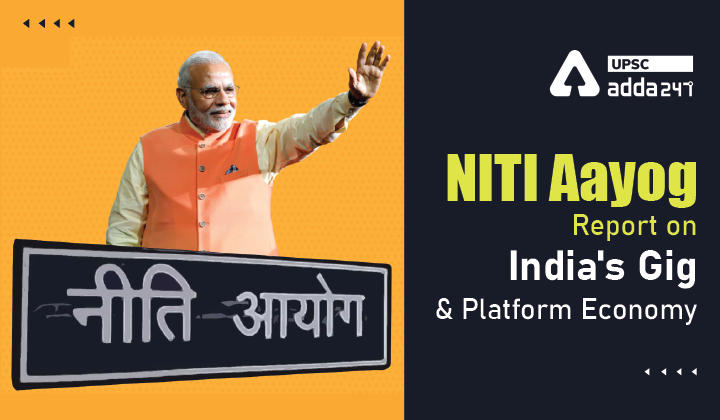Table of Contents
Gig and Platform Economy in India: Relevance
- GS 3: Indian Economy and issues relating to planning, mobilization, of resources, growth, development and employment.
Gig economy in India: Context
- Recently, NITI Aayog has launched a report titled ‘India’s Booming Gig and Platform Economy’ on the gig–platform economy in India.
https://www.adda247.com/upsc-exam/niti-aayog-report-on-indias-gig-and-platform-economy-hindi/
NITI Aayog report on gig economy: Key points
- The report is a first-of-its-kind study that presents comprehensive perspectives and recommendations on the gig–platform economy in India.
- The report provides a scientific methodological approach to estimate the current size and job-generation potential of the sector.
- It highlights the opportunities and challenges of this emerging sector and presents global best practices on initiatives for social security and delineates strategies for skill development and job creation for different categories of workers in the sector.
What is gig economy?
- Gig workers are those workers who are engaged in livelihoods outside the traditional employer-employee arrangement.
- They can be broadly classified into platform and non- platform-based workers.
- Platform workers are those whose work is based on online software apps or digital platforms.
- While, non-platform gig workers are generally casual wage workers and own-account workers in the conventional sectors, working part-time or full time.
Gig economy in India
- It is estimated that there were 68 lakh (8 million) gig workers in 2019-20.
- The gig workforce is expected to expand to 2.35 crore workers by 2029-30.
- The gig workers are expected to form 6.7% of the non-agricultural workforce or 4.1% of the total livelihood in India by 2029-30.
- The employment elasticity to GDP growth for gig workers was above one throughout the period 2011-12 to 2019-20, and was always above the overall employment elasticity.
- The higher employment elasticity for gig workers indicates the nature of economic growth, which created greater demand for gig workers while not generating commensurate demand for non-gig workers.
- At present about 47% of the gig work is in medium skilled jobs, about 22% in high skilled, and about 31% in low skilled jobs.
Recommendations for gig economy in India
To harness the potential of the gig-platform sector, the report recommends
- Accelerating access to finance through products specifically designed for platform workers.
- Linking self-employed individuals engaged in the business of selling regional and rural cuisine, street food, etc., with platforms to enable them to sell their produce to wider markets in towns and cities.
- The report puts forth suggestions for platform-led transformational and outcome-based skilling.
- Enhancing social inclusion through gender sensitization and accessibility awareness programmes for workers and their families.
- Extending social security measures in partnership mode as envisaged in the Code on Social Security 2020.
- Undertaking a separate enumeration exercise to estimate the size of the gig and platform workforce and collecting information during official enumerations ( Periodic Labour Force Survey) to identify gig workers.
Read current affairs for UPSC





 TSPSC Group 1 Question Paper 2024, Downl...
TSPSC Group 1 Question Paper 2024, Downl...
 TSPSC Group 1 Answer key 2024 Out, Downl...
TSPSC Group 1 Answer key 2024 Out, Downl...
 UPSC Prelims 2024 Question Paper, Downlo...
UPSC Prelims 2024 Question Paper, Downlo...
